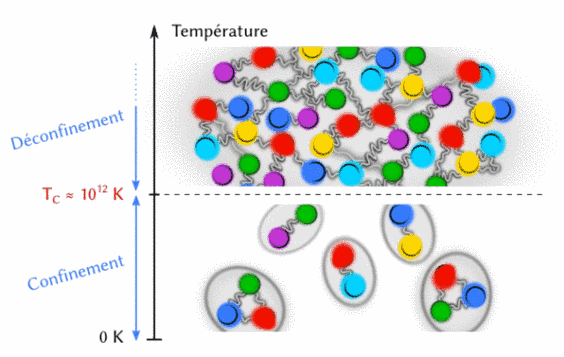26.05.2016
First results of the new international TUMQCD collaboration
The newly founded TUMQCD collaboration headed by Prof. Dr. Nora Brambilla from the Technical University of Munich has published their first results. This study of the high temperature properties of the strong interactions and of the transition from low to high temperatures provided new insights for understanding this transition. Initially this endeavour had been started by the Excellence Cluster Seed-Money project “Simulating the Hot Universe”, and was made possible through use of the local high-performance computing infrastructure, namely the C2PAP computing cluster of the Excellence Cluster Universe and the SUPERMUC high performance computing cluster of the Leibniz Supercomputing Cener in Garching. The results are published in Physical Review D.
The atomic nuclei of the observable matter are generally understood as bound states of neutrons and protons, which are not fundamental particles in contrast to the electrons of the atom's shell. On the level of the Standard Model of Particle Physics, these are considered as bound states of quarks and gluons, whose exceedingly complex interactions, Quantum Chromodynamics (QCD), confines these inside of protons and neutrons.
That is why quarks and gluons cannot be isolated and are not directly observable in experiments. When the temperature is increased beyond a transition temperature of about 1,75 x 1012 Kelvin, the properties of QCD undergo drastic changes and the forces become insufficient to maintain the confinement. In analogy to the ionization of atomic systems this state is called quark-gluon plasma (QGP).
In a QGP the range of interactions is limited such that upon a further increase of the temperature a gradual change from a strongly interacting plasma near the transition temperature to a weakly interacting gas of quarks and gluons takes place at very high temperatures.
In order to study the properties of QGP, the TUMQCD collaboration used computer simulations, in which test charges were inserted into the thermal background of the strong interactions. Through variation of the temperature of the thermal background and measurement of the properties of the test charges like they are encoded in thermodynamic state functions – here the free energy and the entropy – the group around Prof. Nora Brambilla could show that the deconfinement transition actually takes place at a temperature of about 1,75 x 1012 Kelvin.
This result of the TUMQCD collaboration therefore suggests that the transition has a significantly narrower width than is usually believed. Through studies of the high temperature region the group could show that QGP can be generally considered as weakly interacting at temperature of about 3,5 x 1013 Kelvin. The publication appears in Physical Review D.
The basis of this collaboration has been enabled by the Seed Money Project „Simulating the Hot Universe“ of the Excellencecluster Universe and through use of the local computing infrastructure provided by the Excellence Clusters and the Leibniz Supercomputing Center. In particular, the computing clusters C2PAP and SUPERMUC have been used in the framework of multi-year projects. An indispensable contribution to the success of the project consisted of international cooperation and exchange of research data with scientists from Brookhaven National Laboratory.
The scope of the TUMQCD collaboration is to complement effective field theory methods and lattice techniques in a novel framework to calculate the properties of strongly coupled systems at zero and finite temperatures. Interdisciplinary appications inside the TUM-IAS Focal Period PROMISe (Predictive Macroscopic Behaviour from Microscopic Simulators) are also planned.
Members of the newly founded collaboration around Prof. Nora Brambilla including Javad Komijani, Antonio Vairo and Johannes H. Weber from the Technical University Munich and Antonon Bazavov (Indiana University Bloomington, USA), Andreas Kronfeld (Fermilab, USA, as well as TUM-IAS Hans Fischer Senior Fellow), and Peter Petreczky (Brookhaven National Laboratory, USA). Beyond that, the publication itself has been a collaboration with Heng-Tong Ding (Central China Normal University, China) and Hans-Peter Schadler (Brookhaven National Laboratory, USA) and had been financially supported by the Department of Energy, USA, and by Deutsche Forschungsgemeinschaft (DFG) through the Excellencecluster Universe.
Original publication
A. Bazavov et al.: "Polyakov loop in 2+1 flavor QCD from low to high temperatures", Phys. Rev. D, May 2016
arXiv:1603.06637
Contact
Prof. Dr. Nora Brambilla
Technische Universität München
James-Franck-Straße 1
85748 Garching
Germany
Tel.: +49.89.289-12353
E-Mail: nora.brambilla@ph.tum.de






